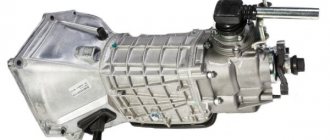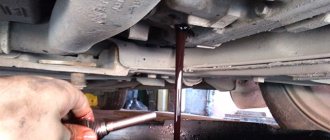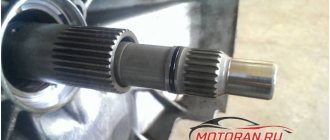The automatic gearbox is the most important and expensive component in a modern car after the engine. To ensure proper movement of the vehicle and stable operation of the device, it is necessary to promptly change the oil in the automatic transmission. Untimely maintenance can damage this unit, which can lead to expensive repairs. In this review we will tell you how, why and why you need to change this technical fluid in the box.
How does oil work in an automatic transmission?
First, let’s remember the principle of operation of the “automatic machine” in a car. This device connects the engine and wheels of the car, converting the torque of the power unit into the energy necessary for movement. In an automatic transmission, the engine crankshaft is connected to a torque converter (GDT), the output shaft of which works with the transmission mechanisms. The latter set the wheels of the car in motion.
Transmission oil, ATF (Automatic Transmission Fluid), is required for the following reasons:
- Ensures normal operation of the node. It transmits torque evenly to the transmission. Thanks to him, the car moves without jerking and smoothly. ATF acts as a kind of clutch pedal in an automatic transmission. The oil uses its body to activate the torque converter parts.
- Actuating mechanism. Having received a command from the ECU (electronic control unit), ATF exerts pressure on certain channels in the device (hydraulic plate), thereby changing gears.
- Removes heat. As a result of the operation of the mechanisms, the metal heats up. Transmission fluid (oil) removes heat into the crankcase, thereby stabilizing the operation of the device.
- Lubrication function. The metal parts of the gearbox are in constant motion, interacting with other components of the unit. They require constant lubrication. This increases their service life, reduces wear, and improves adhesive properties. ATF acts as a lubricant.
- Removal of waste product. When the mechanism operates, metal debris inevitably forms: dust, burrs, shavings, etc. Oil, with the help of additives added to it, helps the device get rid of unnecessary accumulation, facilitating the operation of the mechanisms.
The purpose of the transmission fluid may vary depending on the type of gearbox installed. In a robotic box, for example Getrag 6DCT250, it is necessary for cooling and lubrication of the gearbox. The remaining components of the device are cooled by air.
Is it necessary to change the oil in an automatic transmission?
Several years ago, some manufacturers of well-known brands, for example, the famous German triumvirate: Audi, BMW, Mercedes, wanting to attract attention to their products, announced: there is no need to change the oil. This recommendation was written down in the car’s service book.
Car enthusiasts were delighted with this innovation: no one needed extra expenses. However, the practice of subsequent years has shown that a complete oil change in the gearbox must be carried out. Otherwise, even the most perfect mechanism quickly becomes unusable and wears out.
The manufacturers themselves were convinced of this: the number of automatic transmission failures after reaching a significant mileage has increased significantly.
The industry now offers higher quality technical fluids than before. They are able to withstand critical temperatures and work in extreme conditions. However, this is not a reason to save on buying oil.
Traffic intensity and loads on mechanisms, including gearboxes, have increased significantly. Over time, ATF loses its performance qualities necessary for lubrication, cooling, and driving gearbox parts.
If the fluid is not replaced in time, then over time it becomes filled with debris resulting from the friction of metal components: peeled parts of clutches, linings, decomposition products, and wear. Such an abrasive mixture negatively affects gearbox parts, rendering them unusable.
Checking the oil: frequency and procedure
Perhaps one of the main questions that arises among inexperienced owners of cars with automatic transmission is as follows:
- How to check the oil level in an automatic transmission?
- How often is this procedure required?
First, let's pay attention to the frequency of checking the transmission oil. Most experienced car repairmen recommend carrying out a similar procedure every 5-7,000 kilometers. The inspection period is, of course, flexible, and may well be increased to 10,000 or even 15,000 kilometers, but for your own safety and to guarantee the long service life of the box, they should be reduced as much as possible.
As for the direct control of the liquid, during its implementation it is important to analyze several indicators at once:
- Oil volume in automatic transmission;
- Fluid pressure in the mechanism;
- Transmission oil quality.
Any deviation in the specified parameters indicates that the oil in the automatic transmission must be changed immediately, otherwise the stable operation of the unit is at risk.
Actually determining whether the oil needs to be changed is carried out as follows:
- Warm up the engine to a temperature of 90 degrees Celsius. This is necessary so that the oil temperature in the automatic transmission rises to normal levels of 60-70 degrees;
- Place the car on a flat surface and switch the gearbox to “PARKING” mode;
- Determine where the dipstick is located on the automatic transmission, unscrew and remove it. Then analyze:
- The amount of oil that should be at about. It is only permissible that the automatic transmission fluid does not reach this mark by more than 1 cm;
- Liquid quality. Here it is worth focusing on analyzing the color of the oil. It should be approximately the same as that of the new fluid.
- Then screw the dipstick back in, start the engine, let it run slightly and unscrew the dipstick again. Measure the pressure through the hole in the box. Normally it should be between 2.5-5 bar;
- The identified problems need to be eliminated; if they are absent, you can safely continue operating the automatic transmission.
If in your particular case the box turns out to be without a dipstick, then on its design you should find a special measuring hose, often extending from the oil drain screw. In such “automatic machines”, checking the transmission fluid level is carried out precisely through this hose, or more precisely, by comparing the available amount of lubricant in it with the corresponding measurement on the unit body.
Do not forget that underfilling or overfilling the automatic transmission with oil, as well as loss of its quality or insufficient pressure, are simply unacceptable and can destroy the gearbox over a short operational mileage. With this in mind, always monitor the transmission fluid in your automatic transmission and correct any problems in a timely manner.
When do you need to change the oil in an automatic transmission?
All manufacturers regulate the period for replacing ATF. It is not the same for cars of different brands. The service range, based on the mileage traveled, is from 50 to 120 thousand km. The same BMW AG, which recently advocated for the eternity of its technical fluid, recommends filling in new oil after 50 thousand kilometers or 3 years of operation of the car.
An oil change for a car with normal operation is carried out when the vehicle reaches 60 thousand kilometers or two years of use.
Such an operation should be carried out not only in accordance with the manufacturers’ recommendations, but even earlier, as the ATP’s working qualities expire.
In areas with high humidity and extreme temperatures, such automatic transmission maintenance should be carried out every 30 thousand km or once a year. It is also necessary to replace the transmission fluid ahead of schedule for cars that are used daily under heavy load.
The operating conditions of the machine should be taken into account:
- climate;
- intensity;
- driving style.
I would like to particularly focus on the last point. Some vehicle owners themselves are to blame for the fact that transmission fluid is produced prematurely. This is facilitated by an aggressive or sporty driving style:
- constant alternation of high-speed acceleration with sharp braking;
- kick-down reception (when starting to move, the gas pedal is all the way to the stop at a traffic light);
- taking sharp turns at high speed.
The listed actions force the mechanisms to work under extreme load. Accordingly, the temperature in the assembly increases and the parts heat up. Under such conditions, the oil quickly loses its service life and viscosity and needs to be changed.
Replacement at a service station
Service stations practice partial replacement and complete renewal of the composition of the ATP transmission fluid, which is chosen by the client himself. As a rule, high-quality lubricants of different viscosities are already available, so you only need to bring a filter to your car model. But some services also have consumables for popular car brands in stock in order to save car owners’ time as much as possible.
If the client chooses the partial method, then the waste is removed through the drain hole (if provided by the car manufacturer) or pumped out through the dipstick.
When completely updating the composition with washing, modern equipment is used. They are universal and suitable for all car models. Some are equipped with very simple controls with start and stop buttons. The quality of washing is determined by a fragment of a transparent tube attached to the front panel of the stand.
Other versions of service equipment are equipped with a screen and programs for each make and model of car. They are programmed with the volume of lubricant and other operating parameters that ensure the highest quality replacement of the technical fluid in the box. Bench displacement is considered the best today for servicing automatic transmissions. With it, the resource of the node is extended to 200–250 thousand km. The procedure takes 2–3 hours, but it will need to be done once every 50,000–60,000 km.
How to determine when it is necessary to change the oil?
It is necessary to regularly inspect the technical fluid and listen to the operation of the vehicle’s mechanisms.
Oil in working condition has a reddish color without various impurities and traces of contamination. To do this, you need to remove the dipstick from the device located in the gearbox.
If the following symptoms are detected, you must immediately fill in new ATF:
- The oil has changed color to dark brown.
- There is a burnt smell when viewing the dipstick.
- The appearance of a constant howl while the car is moving, coming from the automatic transmission. When you switch modes, the sound also changes.
- The oil thins out and leaks begin, causing the level to drop.
- The car jerks when moving.
- Unstable operation (possible slipping) of the gearbox.
- Some modes “disappear”: Drive, Reverse.
Also, on most foreign-made brands, an error appears on the information board indicating a faulty automatic transmission.
Draining oil through the plug
Let's merge! If your box has a drain plug at the bottom, first place some large container under it. Usually, its role is played by cut-off plastic canisters, taking into account that several liters of fluid will come out of the transmission (about 3 to 5). Next, unscrew this drain plug and oil will flow out of the neck by gravity. And now you just have to wait until all the liquid that can leak out, accordingly, flows out. After this, screw the drain plug back on. Count the amount of oil drained from the transmission - you will now need to pour the same amount of new fluid inside.
Automatic transmission in Moscow
How to find out what kind of oil was poured into the automatic transmission?
It seems like a simple question, but it can’t always be answered right away. The service book, which indicates the type of product, may be lost, and determining the color of the liquid on the dipstick is problematic. In such cases, you can use the following options:
- in some cases, information is indicated by the manufacturer under the hood on a nameplate;
- call the official representative, dealer;
- find out information on the Internet site.
As a hint, we note the ATF markings used by well-known brands:
- Volkswagen Group - G-052-055, ZF, in extreme cases - ESSO;
- Toyota – ATF Toyota Tire-T;
- BMW – ZF;
- Nissan – Nissan Matic;
- Mercedes – ATF Mercedes.
Original oils are of high quality, but are expensive. In order to save money, we can recommend using a similar product from other manufacturers. To do this, you need to find out the technical parameters: tolerances, viscosity of the original.
Methods for changing the oil in an automatic transmission
If the owner of a car with an automatic transmission does not have the skills in such matters or the desire to engage in such matters, then you should use the services of car service professionals.
Maintenance is carried out using special equipment that, under pressure, introduces new oil into the system, displacing the used one. The advantages of this method are:
- replacement quality;
- ATF changes in full;
- speed of service;
- significant improvement in automatic transmission performance;
- reduction in fuel consumption.
However, there are also negative aspects of such an operation:
- service costs;
- purchasing new oil in increased quantities;
- It is not recommended to carry out such a service on old cars.
The latter is explained by the fact that the “working environment” of the old box is washed away with the waste. It is not a fact that worn-out mechanisms will be able to function normally with fresh oil.
From my own experience
To clearly demonstrate how quickly transmission oil degrades under normal operating conditions, we sent samples taken from the automatic transmissions of Nissan Almera and Datsun mi-DO editorial cars for examination.
The Nissan is equipped with a French 4-speed automatic transmission DP2, and the Datsun is equipped with a Japanese 4-speed Jatco JF414E gearbox. Both cars were filled with factory oil, which was never changed.
Technology for performing work when changing automatic transmission oil yourself
For those who want to save money, there is an option to replace the transmission fluid yourself. If you follow the technology, the work will not cause big problems.
The following nuance must be taken into account. On different brands, the filler necks and drain holes are located in different places. For those who are going to carry out such an operation for the first time, you can go to the Internet and type in the search: how to change the oil in an automatic transmission. There will be a sufficient number of answers for any brand.
Is it worth it?
But really? After all, all oil change steps are described in ideal and simple conditions. But on the way to changing the oil, you will most likely encounter another headache - boiling connections, lack of the necessary tools, and most importantly - lack of experience. After all, if you change the oil incorrectly, there will be a serious risk of damaging the transmission. Out of the blue.
Therefore, it is better to turn to the experts - our ATF replacement service works without intermediaries and has its own rich warehouse of equipment and, of course, intelligence. Experienced technicians carry out all oil change work quickly and cleanly.
You may be interested in these articles:
- Regulations for changing the oil in an automatic transmission. Changing the fluid and necessary consumables. Recommendations for the interval of the next...
- Is it possible to add oil to the automatic transmission? An overheard story. In a well-known chain store of auto parts today I overheard a dialogue between a car enthusiast, a young...
- Changing the oil in an automatic transmission Hyundai i30 At the time it arrived to us, the car had covered 73 thousand km.…
Tags: mercedes benz w639 2.2 how to fill oil into an automatic transmission, Pumping oil from below, how to fill oil into an automatic transmission, how to drain oil from an automatic transmission, change the oil in an automatic transmission, Pumping oil through the dipstick, Draining oil through a plug, Removing the transmission pan, old oil in automatic transmission, dipstick for automatic transmission
Partial replacement
There are two ways to change the oil: partially or completely. In the first case, the fluid in the box is renewed, adding better performance characteristics to the overall mixture.
Order of conduct:
- unscrew the crankcase drain cap;
- drain the oil;
- pour the approximate volume of drained liquid through the neck.
In this way, approximately 35% of the total volume is replaced. This saves money on one-time replacement. Car service technicians advise repeating the procedure several times after 400-600 km.
Experts advise carrying out a complete replacement of the ATF, All automotive fuse box diagrams in one place, which will ensure better operation of the gearbox.











